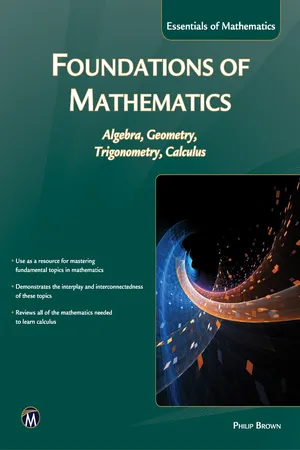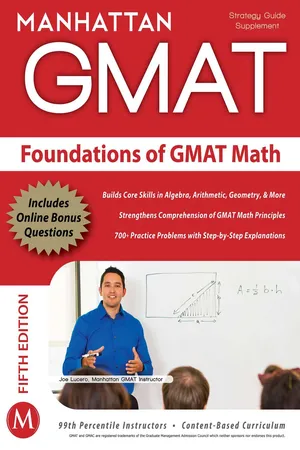Mathematics
The Quadratic Formula and the Discriminant
The quadratic formula is a mathematical equation used to solve quadratic equations of the form ax^2 + bx + c = 0. It is given by x = (-b ± √(b^2 - 4ac)) / (2a). The discriminant, b^2 - 4ac, is a key component of the quadratic formula and determines the nature of the solutions (real, imaginary, or equal) based on its value.
Written by Perlego with AI-assistance
Related key terms
Related key terms
1 of 4
Related key terms
1 of 3
6 Key excerpts on "The Quadratic Formula and the Discriminant"
- eBook - ePub
Foundations of Mathematics
Algebra, Geometry, Trigonometry and Calculus
- Philip Brown(Author)
- 2016(Publication Date)
- Mercury Learning and Information(Publisher)
in order to write the solution:If we allow the usual algebraic processes for taking the square roots of fractions, that is, then the solution simplifies toThese numbers involving are called complex numbers. A convenient way to write complex numbers is to use the notation Then, we can write and so the solution above can be expressed asComplex numbers and the notation i will be explained further in section 3.6 .We now derive the general formula for the solution of a quadratic equation, known as the quadratic formula. In order to solve the equation ax2 + bx + c = 0, we replace the left-hand side of the equation with the expression from formula (3.2). Thus, we need to solve the equationAs in the examples above, this means that The more usual way to write this is to use the ± notation, which means + or −, that is,The quadratic formula provides a shortcut for solving a quadratic equation. All one has to do is identify the values of a, b, and c with the coefficient of x2 , the coefficient of x and the constant term, respectively, and substitute them into the quadratic formula.REMARK 3.3.1. The quantity b2 − 4ac that appears inside the square root in formula (3.3) is called the discriminant. More about this later.EXAMPLE 3.3.5. We can solve the equation −4x2 − 13x + 7 = 0 by substituting a = −4, b = −13, and c = 7 in the quadratic formula, that is,3.4POLYNOMIALS
Polynomials and the algebraic operations that can be applied to them are the main concern of this chapter. We will begin with the formal definition of a polynomial (in one variable) and then explain how polynomials can be added, subtracted, multiplied, and divided. - Alan Sultan, Alice F. Artzt(Authors)
- 2017(Publication Date)
- Routledge(Publisher)
ac . Observe that the left side is a perfect square. Take it from there.- 2 (C) For the quadratic equation ax 2 + bx + c = 0, where a, b , and c are integers, the quantity b 2 − 4ac is called the discriminant. In secondary school the following rule is taught: If the discriminant is 0, there is only one root of the quadratic equation ax 2 + bx + c = 0. If the discriminant is positive and a perfect square, then the two roots are real and rational and unequal. If the discriminant is positive and not a perfect square, the roots of the quadratic equation are irrational and unequal, and if the discriminant is negative, the roots are imaginary. Describe how you would justify these rules to your students. What would you tell them if they asked whether the rules were still true if b is irrational?
- 3 Solve the following quadratic equations by completing the square.
- (a) x 2 − 6x = −8
- (b) y 2 − 7y + 6 = 0
- (c) z (z − 1) + 1 = 0
- (d) 3z 2 − 2z + 1 = 0
- 4 In Figure 3.4 , we have a square and two rectangles.
Figure 3.4- (a) Find the area of the entire figure.
- (b) There is a small square missing that we can add in the lower right hand corner of the figure to make the entire figure a square. What is its area?
- (c) How does this figure relate to the idea of “completing the square?”
5 (C) One of your students was asked to solve x 2 − 8x- eBook - ePub
- Sandra Rush(Author)
- 2017(Publication Date)
- Research & Education Association(Publisher)
a isn’t 1, use the quadratic formula.HINT
All quadratic equations can be solved by using the quadratic formula. This formula is on the formula sheet of the GED® test. Although it looks complicated, it is the go-to way to solve quadratics.4.Use the quadratic formula. Even though you don’t have to memorize this formula, you do have to know how to use it. First, the quadratic equation has to be in the general quadratic equation form of ax2 + bx + c = 0, which may involve combining like terms. Once it is in this form, we need only to determine the values of a, b, and c (they are the coefficients), and plug them into the formula, which isAs we said before, the value of a cannot be zero. There are two reasons for this: (1) if a = 0, the equation would be linear and not quadratic, of the form bx + c = 0; and (2) division by 0 is undefined.The quadratic formula involves a square root. The value under the radical is called the discriminant. The ± sign in the equation gives two different roots unless b2 = 4ac, in which case there are two identical roots, considered as one root (sometimes called a double root). If b2 – 4ac is negative, the roots are imaginary. So quadratic equations always have either 2 real roots, 1 real root, or no real roots.On the GED® test, the discriminant will usually be a common square, such as 16 or 25, but it can also be 7. Remember that you don’t have to know how to find a square root for the GED® test (other than on the calculator), but you should be able to recognize common squares and square roots (see Chapter 3 - eBook - ePub
- (Author)
- 2015(Publication Date)
- For Dummies(Publisher)
Q uadratic (second-degree) equations are nice to work with because they’re manageable. Finding the solution or deciding whether a solution exists is relatively easy — easy, at least, in the world of mathematics.A quadratic equation is a quadratic expression with an equal sign attached. As with linear equations (covered in Chapter 10 ), specific methods or processes, given in detail in this chapter, are employed to successfully solve quadratic equations. The most commonly used technique for solving these equations is factoring, but a quick-and-dirty rule can also be used for one of the special types of quadratic equations. I have to warn you, though, that just because someone puts in some numbers and makes up a quadratic equation, that doesn’t mean there’s necessarily a solution or answer to it. (I show you how to tell if there’s no answer in this chapter.)Quadratic equations are important to algebra and many other sciences. Some quadratic equations say that what goes up must come down. Other equations describe the paths that planets and comets take. In all, quadratic equations are fascinating — and just dandy to work with.Squaring Up to Quadratics
A quadratic equation contains a variable term with an exponent of 2 and no variable term with a higher power.A quadratic equation has a general form that goes like this: ax2 + bx + c = 0. The constants a, b and c in the equation are real numbers, and a cannot be equal to 0. (If a were 0, you wouldn’t have a quadratic equation anymore.)If the equation looks familiar, it means that you’ve read Chapter 9 , which talks about factoring and working with quadratic expressions. Remember: An expression consists of one or more terms but has no equal sign. Adding an equal sign changes the whole picture: Now you have an equation that says something. The equation forms a true statement if the solutions are put in for the variables.Here are some examples of quadratic equations and their solutions:- 4x2 + 5x − 6 = 0: In this equation, none of the coefficients is 0. The two solutions are x = −2 and
- eBook - ePub
Journey into Mathematics
An Introduction to Proofs
- Joseph J. Rotman(Author)
- 2013(Publication Date)
- Dover Publications(Publisher)
j ) in the other]. Squaring ∆ eliminates this ambiguity.Definition. Let f (x ) be a polynomial having n roots α 1 , α 2 , ⋯, α n ; that is, f (x ) = α (x − α 1 ) (x – α 2 ) ∙ ∙ ∙ (x − α n ) for some number a ≠ 0. The discriminant of f (x ) is the numberAs an example, let f (x ) = x 2 + bx + c . The quadratic formula gives the roots as and . Therefore, and so the discriminant is b 2 – 4c .The discriminant of f (x ) is 0 if and only if f (x ) has repeated roots. But this is of no use to us unless we can compute the discriminant, as we have just done for quadratic polynomials, without having first to compute the roots themselves.Let us now concentrate on cubic polynomials. If f (x ) = x 3 + bx 2 + cx + d , then we claim that its reduced polynomial has the same discriminant as f (x ). We saw, in Lemma 4.21, that if α, β, γ are the roots of, , then , , and are the roots of f (x ). Because etc., it follows that both f (x ) and have the same ∆, and, hence, they have the same discriminant A2 . We are going to use the explicit formula in Theorem 4.22 [giving the roots of a cubic f (x )] to give a formula for the discriminant of f (x - eBook - ePub
- Manhattan GMAT(Author)
- 2011(Publication Date)
- Manhattan Prep Publishing(Publisher)
Chapter 7: Quadratic EquationsIn This Chapter:• Manipulating quadratic expressions and solving quadratic equations Mechanics of Quadratic Equations In high school algebra, you learned a number of skills for dealing with quadratic equations. For the GMAT, you need to relearn those skills.Let's define terms first. A quadratic expression contains a squared variable, such as x2 , and no higher power. The word “quadratic” comes from the Latin word for “square.” Here are a few quadratic expressions:
A quadratic expression can also be disguised. You might not see the squared exponent on the variable explicitly. Here are some disguised quadratic expressions.z2 y2 + y – 6 x2 + 8x + 16 w2 – 9 z × z (y + 3)(y – 2) (x + 4)2 (w – 3)(w + 3) If you multiply these expressions out—that is, if you distribute them—then you see the exponents on the variables. Note that the second list corresponds to the first list exactly.A quadratic equation contains a quadratic expression and an equals sign.Quadratic expression = something elseA quadratic equation usually has two solutions. That is, in most cases, two different values of the variable each make the equation true. Solving a quadratic equation means finding those values.Before you can solve quadratic equations, you have to be able to distribute and factor quadratic expressions.Distribute (a + b)(x + y) Use FOILRecall that distributing means applying multiplication across a sum.
You can omit the multiplication sign next to parentheses. Also, the order of the product doesn't matter, and subtraction works the same way as addition. Here are more examples:= 5 × 3 + 5 × 4 equals five times three plus five times four.
Index pages curate the most relevant extracts from our library of academic textbooks. They’ve been created using an in-house natural language model (NLM), each adding context and meaning to key research topics.
Explore more topic indexes
Explore more topic indexes
1 of 6
Explore more topic indexes
1 of 4





